Citroën C4 Picasso 2007 Owner's Manual

I E X T E R I O R
IN BRIEF
Panoramic glass roof |
|
||
Xenon directional |
|
|
Opening rear screen |
|
|
|
|
headlamps |
|
|
|
Whether on dipped beams |
|
|
: 138 |
or main beams, this func- |
|
|
|
tion allows your headlamps |
|
|
|
to follow the direction of the |
|
|
|
road ahead. |
|
|
|
: 94 |
|
|
|
|
|
|
Pneumatic rear |
Front/rear parking |
|
|
suspension |
|
|
The rear pneumatic suspen- |
|
assistance |
|
|
sion enhances driving comfort |
Sensors located in the |
|
|
and maintains a constant body |
bumpers detect obstacles. |
|
|
height whatever the vehicle |
|
|
|
load. |
: 95-96 |
|
|
: 145 |
|
|
|
|
Parking space sensor |
|
|
Exterior side |
|
|
lighters |
|
Measures the size of a space |
|
|
These light up the zones fac- |
and informs you of the possi- |
|
|
ing the driver’s and passen- |
bility of parking. |
: |
76-77 |
ger’s doors. |
|
|
||
4

D
A
B
C
Remote control key
A.Central locking
B.Unlocking
C.Guide-me-home lighting
D.Key release/storage
: 22-23
O P E N I N G |
|
|
Bonnet opening/closing |
|
|
To unlock, pull the control |
locat- |
|
ed under the dashboard |
towards |
|
you. |
|
|
Bonnet stay : detach the stay and |
||||
pivot it upwards to insert it into the |
||||
notch. |
|
|
|
|
To close : |
move |
the |
stay |
|
back |
to its |
initial |
position, |
|
lower |
the bonnet |
and |
then |
|
allow it to slam shut. |
|
|||
|
|
|
: |
163 |
I
|
B |
|
A |
|
BRIEF |
Fuel tank |
|
|
(60 litres) |
|
|
Press on control A located |
on |
|
the control panel to the left of |
the |
|
dashboard. The fuel flap automati- |
IN |
|
cally opens up fully. |
|
|
Insert the nozzle so as to push in |
||
the metallic gate valve B. |
|
|
Push the fuel flap to reclose it. |
|
|
: 162 |
|
|
After switching off the |
|
|
ignition, control A is only active |
|
|
for a few minutes. |
|
|
If necessary, switch on the |
|
|
ignition again to reactivate it. |
5 |
|
|
|
|
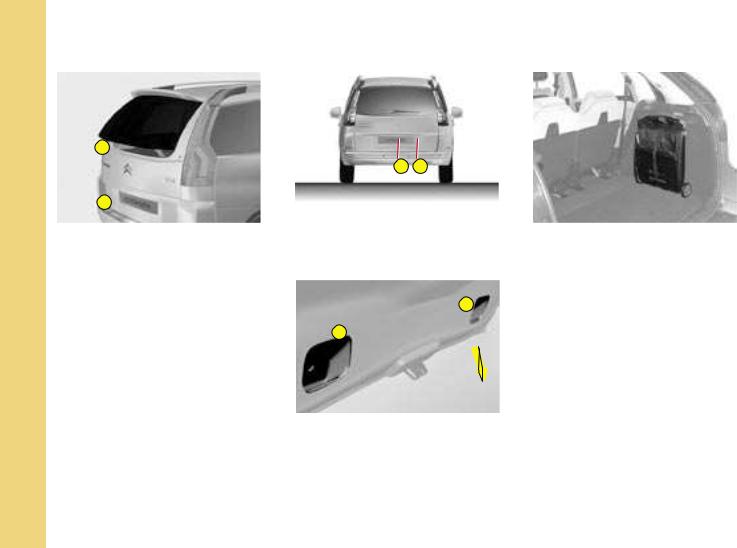
I
O P E N I N G
BRIEFIN
4 
2
Opening rear screen
This opening gives you enhanced access to the boot, even if you are parked close to a wall or to another vehicle.
Opening
-Press on control 2. The handhold 4 is in line with the rear wiper.
Closing - Lower the rear screen.
: 138
|
|
1 |
2 |
|
|
Opening the tailgate |
|
|
|||
- Press on control 1. |
|
|
|||
Note |
: |
You cannot |
open |
the |
tail- |
gate |
if |
the rear screen is already |
|||
open. |
|
|
|
|
|
|
|
|
|
3 |
|
|
3 |
|
|
|
|
Closing the tailgate
-Lower the tailgate, using one of the handholds 3, located on the inside of the tailgate trim.
-Past the balancing point, allow the tailgate to close itself (do not assist it or slow it down).
MODUBOX (22 kg maximum) C4 Picasso
The Modubox is composed of a shopping trolley and a flexible bag which can be used independently of each other depending on your needs.
: 140
6
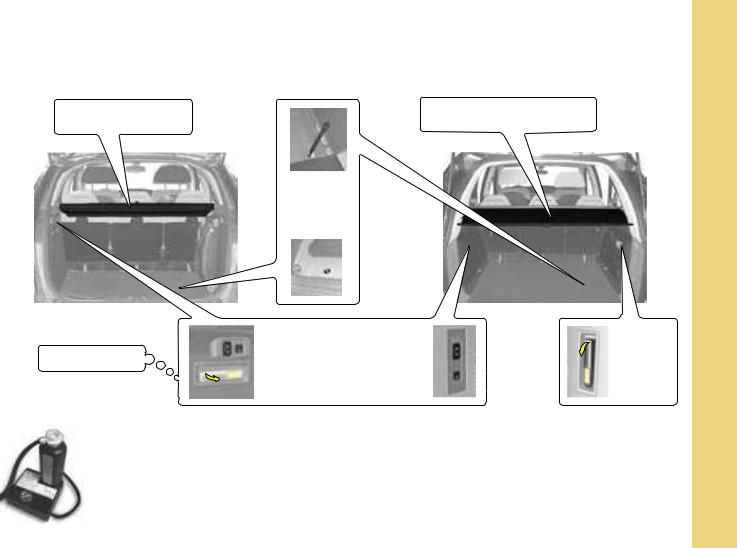
|
B O O T |
I |
C4 Picasso |
|
Grand C4 Picasso |
Luggage cover in |
|
Luggage cover blind |
two sections |
: 139 |
: 142-143 |
Access to
spare wheel : 187
|
|
Pneumatic rear |
|
|
|
suspension |
|
Portable lamp |
Allows the height of the |
||
rear of the vehicle to be |
|||
|
|
||
: |
132 |
adjusted |
|
: 145-146 |
|||
|
|
||
IN BRIEF
Portable
lamp
PUNCTURE REPAIR KIT
The puncture repair kit is located either in the compartment under the left hand second-row passenger or in the boot well (according to equipment).
This puncture repair kit is a complete system including a compressor and a setting product.
: 185 7
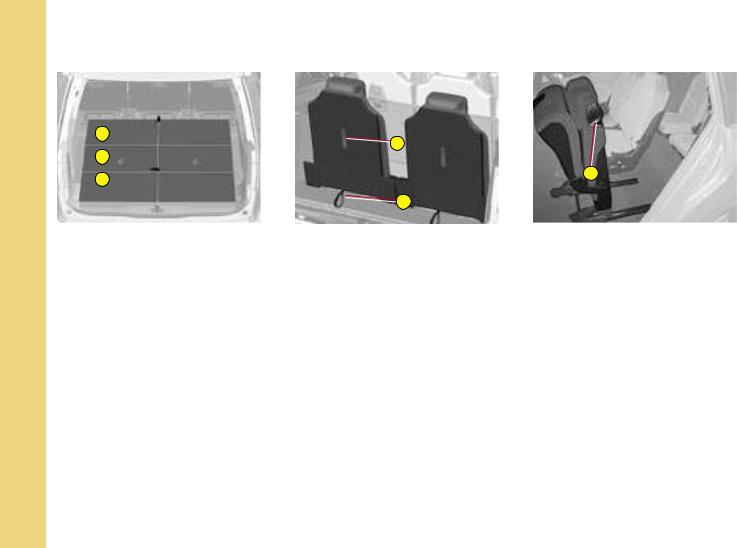
I
IN BRIEF
I N T E R I O R |
C 4 |
T h i r d - r o w s e a t s – G r a n d |
1 |
F |
|
2 |
||
|
3
G
To return the seats to the |
|
upright position |
|
Fold the concertina plates (1 |
2 3) |
arranged on each of the third-row |
|
seats. |
|
Pull on the black belt F located on |
|
the seat backrest. |
|
: |
119 |
To stow the seats |
|
Put the three sections of the con- |
|
certina plates (1 2 |
3) to their ver- |
tical position then |
pull on the red |
belt G. |
|
Before moving the third-row seats, |
|
return the rigid plates to the upright |
|
position and lock them. |
|
Do not leave objects either on or |
|
underneath the second-row seats |
|
when you are folding them. |
|
P i c a s s o
E
Access to third-row seats
Pull on control E located at the top of the second-row seats backrest.
: 118
8
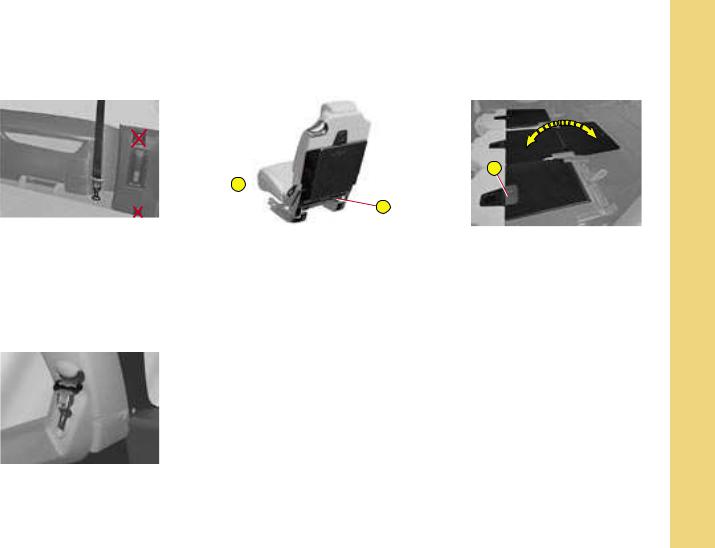
T h i r d - r o w |
s e a t s – |
I N T E R I O R |
S e c o n d - r o w |
||
G r a n d C 4 |
P i c a s s o |
s e a t s |
Requirements for third-row |
|
passenger seat belts |
|
Take care to attach the third-row |
|
passenger seat belts on the rings |
|
provided for this purpose. |
|
Do not attach the |
belts on the |
anchoring points |
marked with |
a red cross (see illustration |
|
above). |
|
Stowing the tongue of the third-row seat belt
: 122
C D
D
TO FOLD THE SEATS
From outside
-Pull upwards on control C as indicated by the red arrow, to unlock the seat.
From the boot - whilst loading, for example (Grand C4 Picasso)
Having firstly folded the third-row seats.
-Pull on control D to unlock the required seat.
TO RETURN THE SEATS TO THE UPRIGHT POSITION
Return the rigid plates of the secondrow seats to their initial (upright) position and lock them in position (Grand C4 Picasso).
Raise the backrest and push it backwards until it locks in position.
: 117
I
A
RIGID PLATE |
|
|
|
BRIEF |
|
(Grand C4 Picasso) |
|
|
|
|
|
A rigid |
plate is attached to |
each |
|
||
second-row seat backrest. |
|
|
|
||
To unlock / lock the rigid plate : |
IN |
||||
- Slide |
latch A of the |
plate down- |
|||
wards, to unlock it. |
|
|
|
|
|
- Return the plate to |
the |
upright |
|
||
position, then slide |
latch |
A up- |
|
||
wards to lock it. |
|
|
|
|
|
Note : |
Before deploying the |
rigid |
|
||
plates, |
check that the |
second-row |
|
||
seats are slid as far back as |
pos- |
|
|||
sible. |
|
|
|
|
|
9
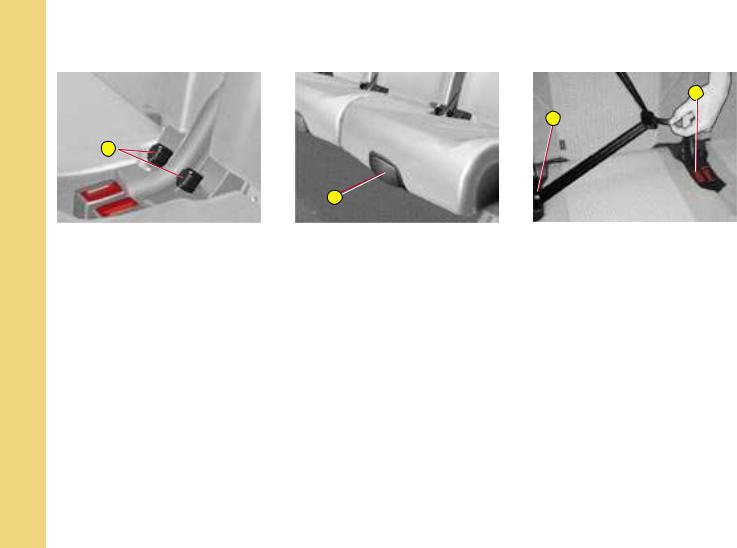
I
BRIEFIN
|
I N T E R I O R |
|
|
|
|
||
|
S e c o n d - r o w s e a t s |
|
|
|
|||
|
|
|
|
|
|
D |
|
|
|
|
|
|
C |
|
|
B |
|
|
|
|
|
|
|
|
A |
|
|
|
|
|
|
THE « COMFORT » POSITION |
LONGITUDINAL ADJUSTMENT |
Positioning the central seat |
|
||||
The 3 second-row seats are inde- |
Lift up |
control A, |
located at |
the |
belt |
|
|
pendent of each other and are all |
front of |
the seat, |
and adjust |
the |
- Insert tongue C into the buckle on |
||
the same width. They can all be ad- |
seat into the desired position. |
|
the |
right, then insert the second |
|||
justed to the « comfort » position. |
|
|
|
|
tongue D into the buckle on the |
||
|
|
|
|
|
left. |
|
|
To place the seat(s) in the |
|
|
|
|
|
|
|
comfort position |
|
|
|
|
|
|
|
- Pull on control B. |
|
|
|
|
|
: |
121 |
The backrest reclines and the seat |
|
|
|
|
|
||
base pivots slightly. |
|
|
|
|
|
|
|
To return the seat to its original |
|
|
|
|
|
|
|
position |
|
|
|
|
|
|
|
-Pull on control B and allow the seat to come forward.
10
:
115
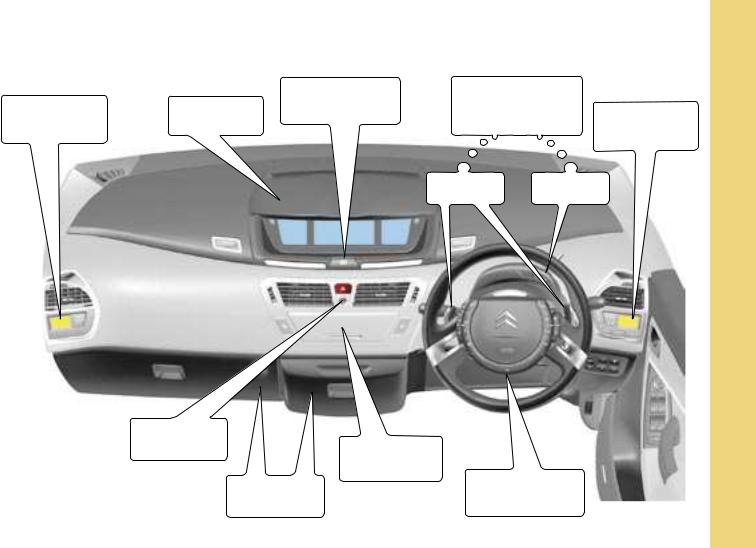
|
|
D A S H B O A R D |
|
|
I |
|
|
Automatic |
Manual and |
|
|
|
|
electronic parking |
|
||
Passenger’s |
Instrument |
automatic gearbox |
|
||
brake control |
Driver’s |
||||
air conditioning |
panel |
|
controls |
|
|
controls |
|
|
|
|
air conditioning |
|
|
|
|
controls |
|
|
|
|
|
|
|
|
|
Gear control |
Selector |
|
|
|
|
levers |
IN BRIEF |
||
|
|
|
|||
|
|
|
|
|
|
Scented air freshener
|
Radio-CD |
Refrigerated |
Fixed centred |
controls steering |
|
storage |
wheel |
: 29 11

I
G E T T I N G |
S T A R T E D |
F r o n t |
s e a t s |
Manual adjustments |
|
Head restraint |
|
2 |
1 |
|
3
BRIEFIN
:
12
111
Armrest
Backrest angle
Driver’s seat height adjustment
Longitudinal adjustment
Lumbar support
Electric adjustments : |
|
|
|
Adjustment of seat height |
|
|
and angle, longitudinal |
|
|
adjustment |
|
Adjustment of backrest angle |
||
|
and lumbar support |
|
Driver : memorisation of |
|
|
|
driving positions |
|
Note : The seats can also be ad- |
||
justed on a temporary basis |
: |
|
-on opening one of the front doors,
-after switching on the ignition.
Heated seat control (located on the inside of the front seats)
: 112
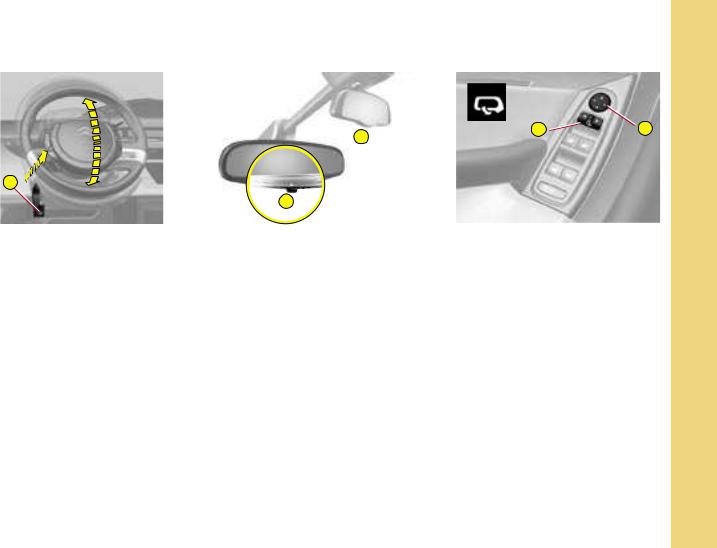
G E T T I N G |
S T A R T E D |
I
A |
|
Adjusting the steering wheel |
|
The steering wheel can be adjusted |
|
in terms of height and reach. |
|
Unlock the steering wheel by pull- |
|
ing control |
A towards you. |
Adjust the |
position of the steer- |
ing wheel then lock it pushing the |
|
control back fully. |
|
|
: 86 |
2
1
Automatic photochromic interior rear view mirror
This modifies its role automatically and progressively between day use and night use.
It can be deactivated using control 1.
Child mirror (2)
This allows you to monitor the rear passengers. It can be folded away to eliminate dazzle.
: 84
1 |
2 |
Rear view mirrors |
||
adjustment |
|
|
This operates with the ignition |
||
switched on. |
|
|
From the driver’s |
seat, select the |
|
rear view mirror by moving control |
||
1 to the left or right, then adjust |
||
the rear view mirror as required in |
||
the 4 directions using control 2. |
||
Demisting-deicing of the rear view |
||
mirrors is linked to that of the rear |
||
screen. |
|
|
Rear view mirrors foldback |
||
When the |
vehicle |
is parked, the |
rear view |
mirrors |
can be folded |
back either manually or automati- |
||
cally. |
|
|
|
|
: 85 |
BRIEFIN
13
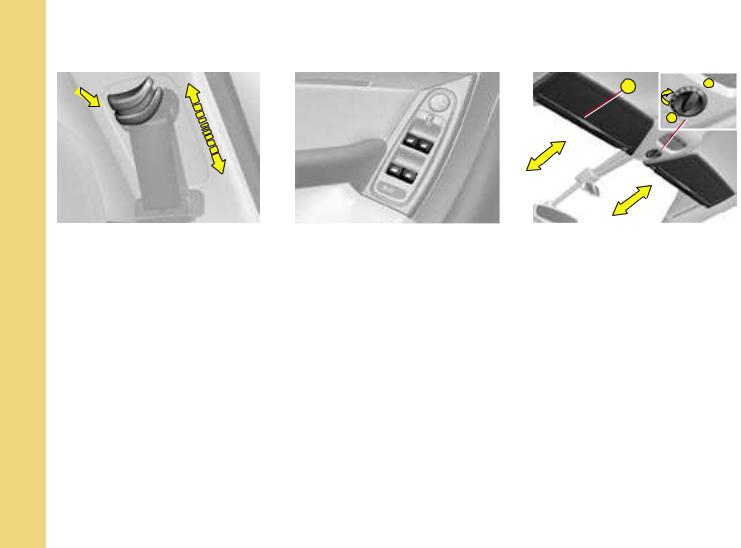
I
G E T T I N G |
S T A R T E D |
A |
9 |
|
|
|
0 |
IN BRIEF
Adjusting the seat belt |
|
|
height |
|
|
To adjust the seat belt, |
pinch |
the |
control and slide it in the direction |
||
required. |
|
|
|
: |
86 |
Electric windows |
|
|
controls |
|
|
From the driver’s |
seat |
position, |
the controls located on |
the door |
|
enable the electric windows to be |
||
controlled. |
|
|
|
|
: 97 |
Sliding sun visors
-Slide the blind on the visor to the desired position by pushing the area A.
The blinds are |
extended |
on |
the |
sun visor struts. |
|
|
|
-Fold the visor downwards, to protect against being dazzled.
Panoramic glass roof blind |
|
Opening (positions 1 to 9) |
|
Closing (position 0) |
|
The blind has an anti-pinch |
de- |
vice. |
|
: 87
14
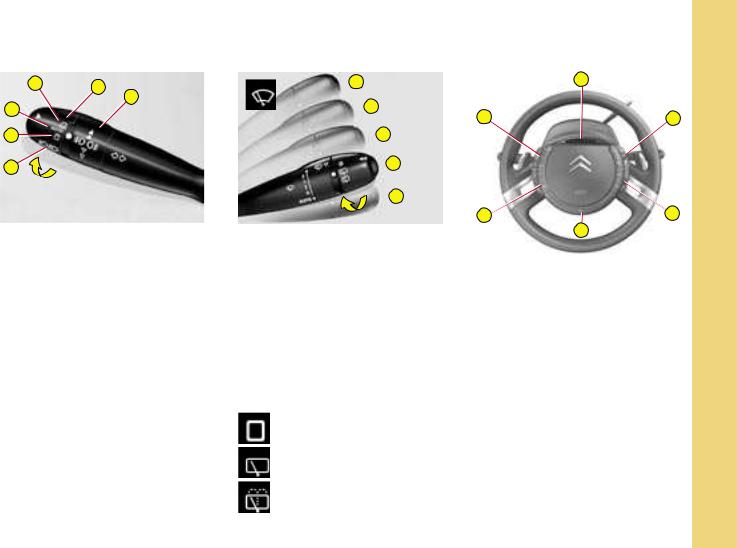
1 |
A |
B |
2 |
|
|
|
|
|
3 |
|
|
4 |
|
|
LIGHTING CONTROL
Ring A
1Off
2Automatic lighting
3Sidelamps
4Dipped beams / Main beams
Ring B
Front foglamps
Rear foglamps
: 80
|
D R I V I N G |
|
3 |
|
2 |
|
1 |
|
0 |
|
4 |
Windscreen wiper |
|
3 |
Rapid wipe. |
2 |
Normal wipe. |
1 |
Intermittent wipe. |
0 |
Off. |
4Automatic wipe by pressing downwards, and single wipe.
Note : To deactivate automatic wipe :
-go to position 1, then return to position 0.
Rear screen wipe |
|
Stop. |
|
Intermittent. |
|
Timed wash and wipe. |
|
: |
82-88 |
I
|
A |
F |
B |
E |
C |
BRIEF |
|
||
|
D |
|
A |
Warning lamps for vehicle |
|
B |
lamps and direction indicators |
|
Audio system controls |
IN |
|
C |
Multifunction display |
|
D |
Horn |
|
|
controls |
|
E |
Optional function controls |
|
F |
Cruise control and speed |
|
|
limiter |
|
15
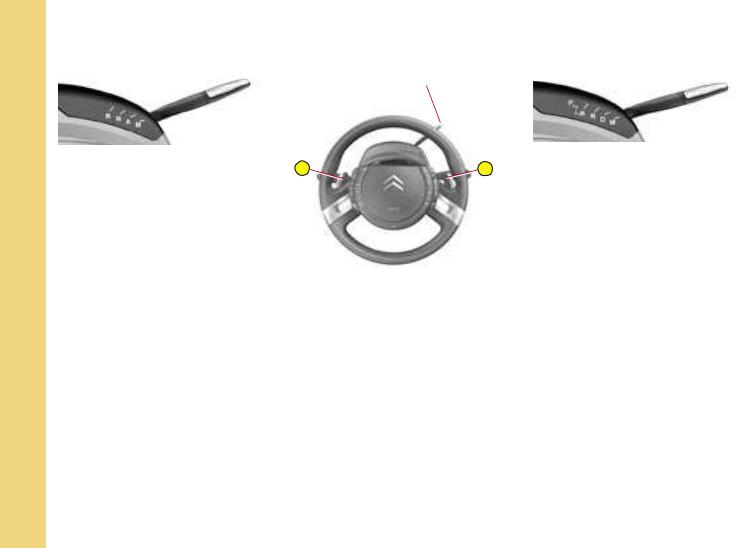
I
IN BRIEF
Position
selector
(6-Speed) electronic gearbox |
|
system |
|
R |
Reverse |
N |
Neutral |
A |
Automatic mode |
M |
Manual mode |
Using control levers + and - : |
|
-Gear changing in manual mode
-Temporary manual operation in automatic mode.
To start
(6-Speed) electronic gearbox system
-Check that you are in neutral (position N).
-Press firmly on the brake pedal and turn the ignition key.
: 58-62
D R I V I N G
Position selector
Control |
Control |
– |
+ |
Position
selector
Automatic gearbox |
|
P |
Park |
R |
Reverse |
N |
Neutral |
D |
Automatic mode |
M |
Sequential mode |
Using control levers + and - : |
|
-Gear changing in sequential mode
-Temporary manual operation in automatic mode.
To start
Automatic gearbox
-Check that you are in position P or N and turn the ignition key.
Note : To exit position P, press on the brake pedal before moving the selector.
: 63-66
16

A
Electronic parking brake
This device combines :
-automatic functions :
Automatic application when the engine stops and automatic release on use of the accelerator (automatic operation by default) ;
-manual use :
Permanent manual application / release of parking brake is possible by pulling control A.
|
: 68-74 |
Hill start assist |
|
To aid starting on a gradient, your |
|
vehicle is equipped with a system |
|
which |
keeps it immobilised for |
about |
2 seconds, the approximate |
time it takes to move your foot |
|
from the brake pedal to the accel- |
|
erator pedal. |
|
|
: 75 |
D R I V I N G |
I |
|
Before leaving the vehicle, |
||
check that the electronic |
||
parking brake warning lamp P |
||
(red) is permanently on. |
||
If you leave the vehicle with |
||
the engine running, manually |
||
apply the parking brake. |
||
Never leave a child alone |
||
inside the vehicle with the |
||
|
ignition on, |
|
as they could release the |
||
|
parking brake. |
|
Warning |
Instrument |
Warning |
lamps display |
panel |
lamps display |
Multifunction display |
|
|||
: |
32-33 |
|||
Instrument |
|
|
||
panel |
|
|
||
|
|
|||
Navidrive |
|
Multifunction |
|
|
|
|
|||
display |
|
|
||
|
|
|
: |
34 |
< 20 km/h |
|
(approx. 12 mph) |
|
Parking space sensor |
|
A |
BRIEF |
You can select the « parking space sen- |
|
sor » function by pressing on button A. |
|
Once the space has been measured, the |
|
function displays the following messages : |
|
Parking possible |
IN |
|
|
Parking difficult |
|
Parking not advised
: 76-77 |
17 |
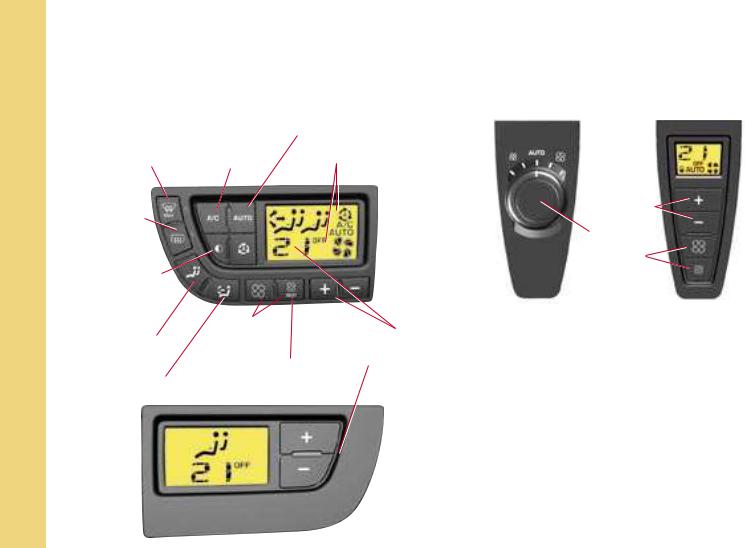
I
|
|
V E N T I L A T I O N |
|||
|
A u t o m a t i c |
a i r |
c o n d i t i o n i n g |
||
DRIVER’S AND PASSENGER’S |
REAR PASSENGERS’ CONTROL |
||||
|
CONTROL PANEL |
|
PANEL |
||
Rapid deicing / |
Automatic comfort |
|
|
||
demisting of front |
|
regulation |
Air recirculation, |
||
and rear windows |
Air |
|
|||
|
automatic |
||||
and rear view |
conditioning |
|
|||
(depending on version) |
|||||
mirrors |
|||||
|
|
|
|
||
IN BRIEF
Deicing / demisting of rear screen and rear view mirrors
Black panel function (extinction of air conditioning displays and button backlighting)
Mode of adjustment for rear passengers
Adjustment of air distribution
Adjustment of air blower speed
REST function (retention of ventilation with the engine switched off)
Adjustment and display of temperature
(comfort requirement)
Temperature
adjustment
Adjustment of air blower speed
With additional air conditioning (no warm air distribution)
: 104-110
18
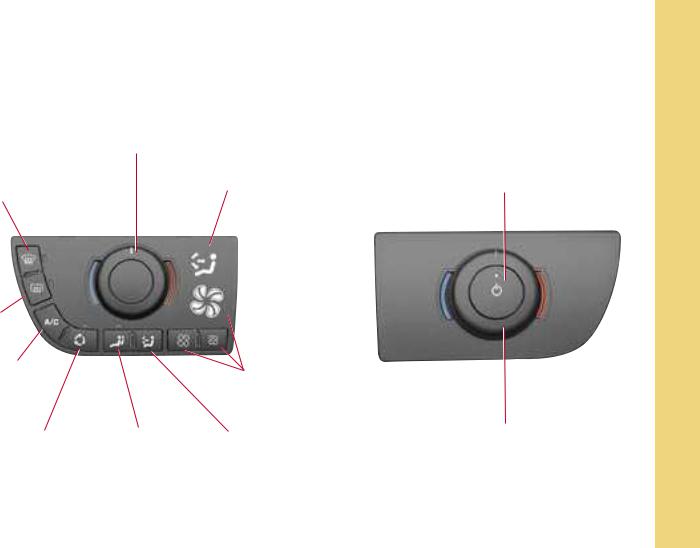
H e a t i n g
V a n
E d
N m
T I L a n u a
A l
T a i
I r
O N c o n d i t i o n i n g
I
DRIVER’S CONTROL PANEL
Adjustment of blown air temperature
Rapid deicing / demisting of front and rear windows and rear view mirrors
Deicing / |
|
demisting of rear |
|
screen and rear |
|
view mirrors |
|
Air conditioning |
|
(not available in |
|
heating version) |
|
Air recirculation |
Mode of |
|
temperature |
|
adjustment for |
|
passenger |
Display of air distribution
Adjustment and display of air blower speed
Adjustment of air distribution
PASSENGER’S CONTROL PANEL
Status of temperature adjustment (active/inactive)
IN BRIEF
Temperature
adjustment
: 101-103
19
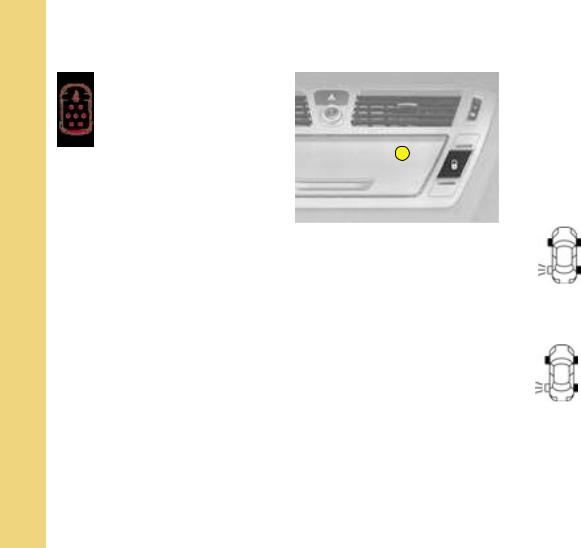
I
Seat belts not fastened / unfastened warning lamp
|
This warning lamp informs you if the |
|
front passenger’s seat belt is not |
|
fastened / unfastened and if the sec- |
BRIEFIN |
ondand third-row rear passengers’ |
seat belts are unfastened. The lit up |
|
positions represent the passengers |
|
|
whose seat belts are not fastened / |
|
unfastened. |
|
: 36 |
M O N I T O R I N G
A 
Locking from inside
You can use electrical central locking or unlocking by pressing on button A.
If one of the doors is open or is not closed properly, central locking will not work.
Anti-intrusion security
When starting the engine, the system automatically locks the doors once you reach approximately 10 km/h (approximately 6 mph).
: 98
Tyre deflation detection
This function warns you if a tyre is deflated or punctured.
This system does not absolve the driver of the need to regularly check the tyre pressures.
Deflation warning
The SERVICE warning lamp lights up, and a vehicle outline is displayed, accompanied by a message and a sound signal.
Puncture
The STOP warning lamp lights up, and a vehicle outline is displayed, accompanied by a message and a sound signal.
: 190
20
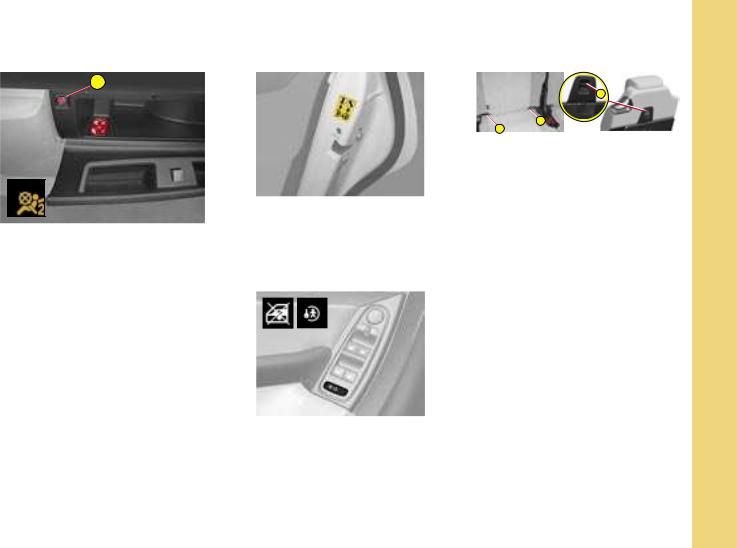
P A S S E N G E R |
S A F E T Y |
I
A
Deactivation of front passenger airbag
1.Insert key into (A).
2.Select «OFF» position.
3.Remove key.
: 123
CHILD SAFETY |
|
Manual control |
|
The rear doors are locked by op- |
|
erating the lever |
(aperture at an |
angle). |
|
|
|
C |
|
|
A |
|
B |
|
|
|
|
|
|
|
ISOFIX fixing system |
|
|
||
The |
3 |
second-row |
rear |
seats |
and |
the |
front passenger |
seat of |
|
your |
vehicle are fitted with regu- |
|||
lation ISOFIX anchoring |
points, |
|||
with |
3 rings for each seat position |
|||
(A B C). |
|
|
|
|
This |
fixing system is designed for |
|||
children weighing up to 18 kg. |
||||
: 128
IN BRIEF
Electric control |
|
|
Pressing on |
the |
button prohibits |
operation of |
the |
electric windows |
and opening of the rear doors from |
||
the rear of the vehicle. |
||
|
|
: 124 |
21
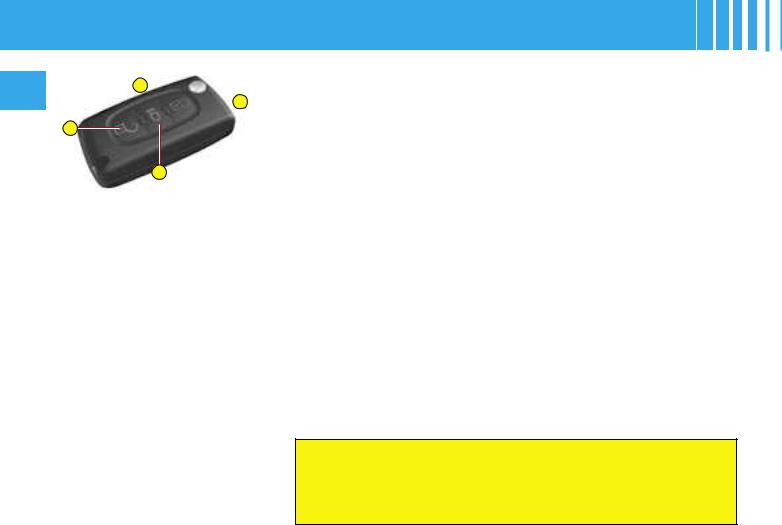
REMOTE CONTROL
II D A
A
B
C
Central unlocking
-A short press on button B unlocks your vehicle.
The unlocking is confirmed by the flashing of the direction indicators, and by the disarming of the alarm if the vehicle has one.
The unlocking activates:
-the deployment (to the last position registered) of the exterior rear view mirrors,
-the direction indicator side repeaters (located underneath the exterior rear view mirrors),
-the timed lighting of the interior lamps and the sill lighting for around 30 seconds,
-the timed lighting of the exterior side lighters (located underneath the exterior rear view mirrors) for around 30 seconds.
22
Note : if none of the doors is opened within thirty seconds following unlocking, the doors automatically relock.
Central locking - Deadlocking
-A short press on button A locks your vehicle.
-A long press on button A also closes the windows and the panoramic glass roof blind.
The locking is confirmed by the continuous lighting of the direction indicators and the arming of the alarm.
The locking activates:
-folding of the exterior rear view mirrors,
-operation of the guide-me-home lighting, if it is activated,
-the exterior side lighters.
If any of the doors, or the boot, is open or not properly closed, a rebound sound signals to you that it is impossible to lock the vehicle.
For vehicles equipped with deadlocking, two successive presses on button A deadlock the vehicle. It is then impossible to open the doors either from the inside or from the outside.
Selectivity of doors
If you have selected « driver » in the « access to the vehicle » menu of the multifunction screen :
-a press on button B opens the driver’s door,
-a second press opens all the doors.
This function is not available using the key.
It is dangerous to operate the deadlocking when someone is inside the vehicle because it is impossible to unlock the vehicle from the inside (without the remote control).
When you are closing the windows and/or the panoramic glass roof blind with the remote control, you must make sure that no-one is obstructing them from closing properly.

REMOTE CONTROL
Guide-me-home lighting
A press on button C operates the guide-me-home lighting (lighting of the sidelamps, dipped beams, number plate lamps and side lighters (located underneath the exterior rear view mirrors).
A second press before the end of the timing cancels the guide-me- home lighting.
Vehicle location
To locate the vehicle on a carpark, press button A. The location of the vehicle is revealed by :
-the flashing of the direction indicators and side repeaters for a few seconds,
-the lighting of the interior lamps for around 30 seconds,
-the lighting of the side lighters. The vehicle remains locked.
Foldaway and ejection of the key
Button D folds the key in and out of its housing in the remote control.
If you do not press on button D, you could damage the mechanism.
Remote control battery spent
This information is given by a message on the multifunction screen, accompanied by a sound signal and the lighting of the SERVICE warning lamp.
Changing the remote control battery
Detach the housing to access the battery. Battery : CR 0523, 3V.
Re-initialising the remote control
After a change of battery, it is necessary to re-initialise the remote control. For that, switch on the ignition and immediately press button A on your remote control until the action desired is triggered. This manœuvre may take some ten seconds.
Note : Make a careful note of the numbers for your keys and remote control on the ASSISTANCE card. Keep this in a safe place.
Do not throw away spent batteries. Return them to a CITROËN dealer or to an approved collection point (photo shops, etc.).
Simultaneous use of other high frequency equipment (mobile telephones, domestic alarms, etc.) may interfere temporarily with the operation of the remote control. If it malfunctions on a permanent basis, you must re-initialise the remote control.
Except for re-initialisation, the remote control cannot function while the key is in the ignition, even with the ignition switched off.
Be aware that an inadvertent manipulation of
the remote control in your pocket could cause the vehicle doors to unlock without your knowledge.
However, if no door is opened within thirty seconds following an unlocking, the doors will automatically relock.
Warning : there is a risk of damage if the replacement battery is not in conformity.
Use only those batteries that are identical or equivalent to those recommended by CITROËN.
II
23
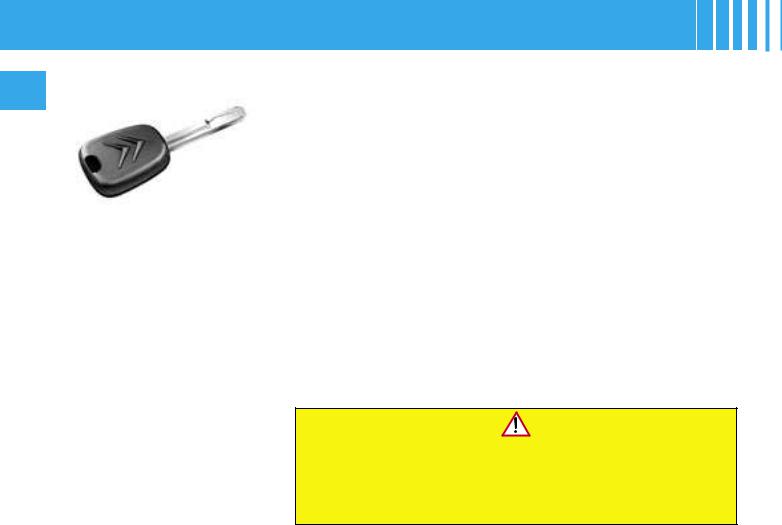
KEYS
II
Electronic immobiliser key
The key locks and unlocks all the vehicle’s doors, as well as switching on the engine.
Note : For security reasons when the ignition is switched off, when the driver’s door is opened a sound signal reminds you if you have not removed the key.
The key can also deactivate the front passenger airbag (see «Airbags»).
24
Central locking with the key
Turn the key briefly in the door lock. The vehicle is locked.
Deadlocking : Central locking with the key
Turn the key a second time in the door lock. The vehicle is deadlocked. It is then impossible to open the doors from the inside or from the outside.
A long action with the key closes the windows.
Note : With the vehicle stationary and the engine switched off, locking is signalled by the flashing of the warning lamp on the interior locking control.
If any of the doors, or the boot, is open or not properly closed, a rebound sound signals to you that it is impossible to lock the vehicle.
Electronic immobiliser
The ELECTRONIC IMMOBILISER locks the vehicle’s supply system. The system activates automatically when the key is removed from the ignition. All the vehicle keys contain an electronic immobiliser device.
After you switch on the ignition, a dialogue is established between the ignition key and the electronic immobiliser device.
If the key is not recognised, starting is impossible.
If this happens, leave your vehicle immobilised and contact a CITROËN dealer.
It is dangerous to operate the deadlocking when someone is inside the vehicle because it is impossible to unlock the vehicle from the inside (without the remote control).
The number of the key is on the label supplied with the key.
In the case of loss, only a CITROËN dealer can provide you with new keys or remote controls.

CODE CARD
A confidential card is given to the new owner when he takes delivery of his new vehicle.
This card bears a hidden access code for the use of the CITROËN dealer when servicing the electronic immobiliser device.
Do not scratch the confidential strip, the security of the immobiliser system depends on the information below remaining covered.
Should the card be lost, your immobiliser system can no longer be considered secure.
In the event of a change of vehicle ownership, it is essential for the new owner to possess the CODE card.
Never leave it in the vehicle.
Advice
Keep the code card bearing your personal electronic immobiliser number in a safe place (never in the vehicle).
If any key modifications become necessary (addition, cancellation or replacement of the key), It is essential to take the confidential card together with all the keys to a CITROËN dealer.
Never attempt to modify the electronic immobiliser’s electrical circuit, as that could render your vehicle undriveable.
Should the confidential card become lost, a CITROËN dealer would have to undertake a major repair.
II
25

ANTI-INTRUSION ALARM
II
A
B
1 |
Your vehicle may be equipped with an ANTI-INTRUSION ALARM.
This provides :
•Exterior perimeter protection by means of detectors on the vehicle access points (doors, boot, bonnet) as well as on the electrical supply.
• Interior |
volumetric |
protection |
||
by means |
of ultrasonic sensors |
|||
(detecting |
movement |
inside the |
||
passenger |
compartment). |
This |
||
can be |
deactivated |
using |
the |
|
control 1. |
|
|
|
|
The installation also has a siren, and a warning lamp on the control 1 which is visible from outside the vehicle, indicating the three possible statuses of the alarm:
•Alarm not active (disarmed), warning lamp off.
•Alarm active (armed), the warning lamp flashes slowly.
•Alarm triggered (signalling an intrusion), the warning lamp flashes rapidly if the alarm is disarmed by a press on the control B. It stops as soon as you switch on the ignition.
Note : If |
there |
is a malfunction, |
the warning lamp remains perma- |
||
nently on. |
|
|
26
DISARMING OF THE ALARM USING THE REMOTE CONTROL
The alarm is disarmed when you unlock the vehicle (with a press on button B on the remote control).
DISARMING OF THE ALARM WITH THE KEY
Unlock the doors with the key. The siren triggers. Enter the vehicle, insert the key in the ignition and turn it to the drive position to stop the siren. Otherwise the siren will continue for approximately 30 seconds.

ANTI-INTRUSION ALARM
OPERATION OF THE ALARM
First make sure all the doors are closed.
The alarm is armed by pressing button A on the remote control.
With the alarm armed, the protections are active after 5 seconds (perimeter) and 45 seconds (volumetric).
When the alarm is armed (on standby), any intrusion will trigger the siren for 30 seconds, accompanied by the direction indicators lighting up.
The alarm then goes back on standby, but the triggering remains memorised and is signalled by the rapid flashing of the warning lamp on control 1 after you have deactivated the alarm with a press on the unlocking button B. The flashing stops when you switch on the ignition.
The siren is also triggered if there is a cutting of the electrical supply. To stop it, restore the electrical supply then press on the unlocking button B.
Note :
•If you want to lock your vehicle without arming the alarm, just lock with the key only.
•If you try to lock your vehicle but a door, or the boot, is still open, the central locking does not operate but the alarm will arm itself after approx. 45 seconds. You will hear a rebound sound coming from the locks.
Note : The siren is automatically deactivated (for example for disconnecting the battery) as soon as the vehicle is unlocked using the remote control
|
|
|
|
|
|
|
|
|
|
|
|
|
|
|
|
|
|
|
|
|
|
Deactivation of the volumetric detection |
|
II |
||||||||
You can operate the alarm with perimeter protection |
|
|
|
|
|
|||||
|
|
|
|
|
||||||
only, by deactivating the volumetric protection (if for |
|
|
|
|
|
|||||
example you wish to leave an animal in the vehicle). |
|
|
|
|
|
|||||
For this, switch off the ignition then immediately press |
|
|
|
|
|
|||||
button 1 for at least one second. |
|
|
|
|
|
|||||
The warning lamp on button 1 should come permanent- |
|
|
|
|
|
|||||
ly on. It will start to flash when the alarm is armed. |
|
|
|
|
|
|||||
Arm the alarm by locking your vehicle with the remote |
|
|
|
|
|
|||||
control. |
|
|
|
|
|
|||||
It is recommended to disarm the volumetric detection |
|
|
|
|
|
|||||
when you use an automatic car wash, to prevent ran- |
|
|
|
|
|
|||||
dom triggering of the alarm. |
|
|
|
|
|
|||||
Automatic activation (according to destination) |
|
|
|
|
|
|||||
The alarm is armed automatically, 2 minutes after the |
|
|
|
|
|
|||||
last door, or the boot, has been closed. |
|
|
|
|
|
|||||
In order to prevent the alarm from triggering when you |
|
|
|
|
|
|||||
open one of the doors or the boot, it is essential to press |
|
|
|
|
|
|||||
the unlocking button B again on the remote control. |
|
|
|
|
|
|||||
27
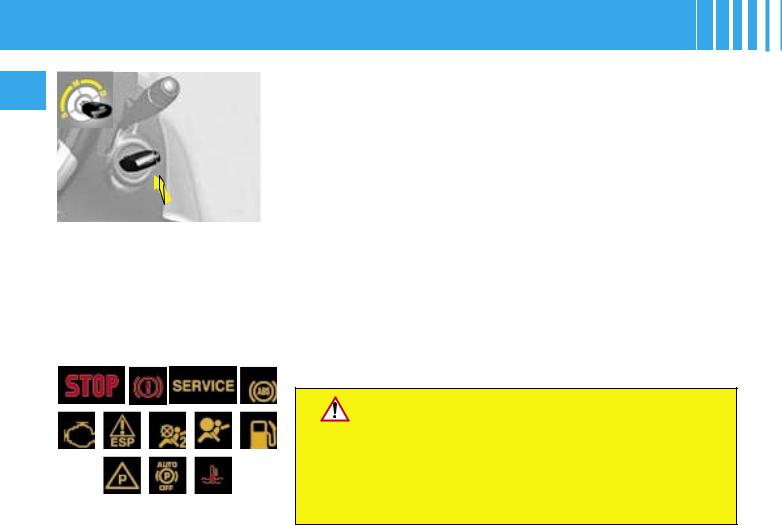
STEERING LOCK - IGNITION - STARTER
II
•S : Steering lock
To unlock the steering, gently move the steering wheel while turning the key, without forcing it.
•M : Drive position
Depending on the version of your vehicle, the following warning lamps should also come on for a short time :
•D : Starter
Release the key as soon the engine has started. Never action the key while the engine is already running.
Steering lock
S : After removing the key, turn the steering wheel to lock the steering. The key can only be removed in position S.
M : Ignition switched on, the steering is unlocked (by turning the key to position M, move the steering wheel gently if necessary).
D : Starter position.
Starting and stopping the engine : see « Starting ».
Economy mode
To ensure engine starting, in certain situations the vehicle goes into economy mode.
The electrical components relating to comfort and lighting of headlamps (except side markers) are automatically cut off.
To reactivate them, it will be necessary to restart the engine.
Note : When the vehicle goes into economy mode, a message displays.
|
|
|
|
Test with the key in |
|
|
|
|
|
|
|
|
|
|
|
|
|
|
|
|
|
|
|
|
|
|
|
|
|
28 |
|
|
|
the ignition position |
NEVER REMOVE THE IGNITION KEY BEFORE THE VEHICLE HAS COME TO A COMPLETE STOP.
IT IS ESSENTIAL ALWAYS TO KEEP THE ENGINE RUNNING
IN ORDER TO RETAIN BRAKING
AND STEERING ASSISTANCE
(risk of triggering the steering lock and rendering the safety features inoperative).
When stationary, having removed the key, turn the steering wheel gently if necessary to ensure that the steering lock engages.
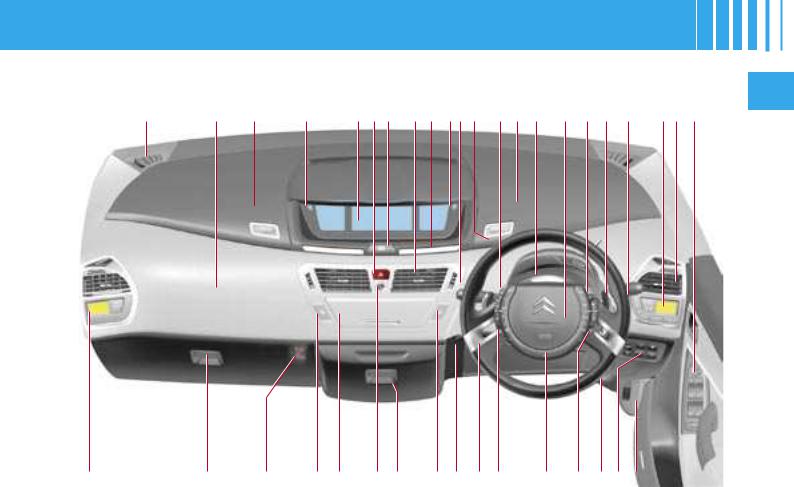
DASHBOARD
21 |
20 |
19 |
13 |
17 18 16 |
15 14 13 12 11 |
10 |
9 |
8
II
7 |
6 |
5 |
4 |
3 |
2 |
1 |
22 |
23 |
24 |
25 |
26 |
27 |
28 |
29 |
30 |
31 |
32 |
33 |
34 |
35 36 37 |
29

II
30
DASHBOARD
1Side air vent
2Loudspeaker (Tweeter) (right and left)
3Passenger’s airbag
4Right hand upper storage
5Controls :
•Trip mileage recorder reset button
•Lighting rheostat
•Colour (choice of background colour)
•Personalisation
6Instrument panel
7Hazard lamps control
8Automatic electronic parking brake
9Central air vents
10Warning lamps display
11Controls :
•Lighting
•Direction indicators
•Front and rear foglamps
12Gear controls
13Cruise control and speed limiter (controls on steering wheel)
14Left hand upper storage
15Direction indicator warning lamps
16Driver’s airbag
17Radio-CD controls on steering wheel
18Selector/controls for automatic gearbox or electronic gearbox system (6 speed)
19Controls :
•Windscreen wipe
•Screen wash
•Rear screen wipe
•Trip computer
20Driver’s air conditioning controls
21Controls :
•Rear view mirrors
•Windows
•Child safety
22Bonnet release
23Controls :
•Fuel flap
•Parking assistance
•Lane departure warning system
•Alarm deactivation
•Headlamps adjustment
24Steering lock - ignition
25Controls for multifunction display (on steering wheel)
26Horn
27Optional function controls (on steering wheel)
28Ambiance lighting control
29Central locking button
30Refrigerated storage
31Scented air freshener
32Radio-CD
33ESP deactivation button
34Key switch :
•Passenger’s airbag activation/deactivation
35Lower glovebox :
•Air freshener clips
•Various storage
36Fusebox access flap
37Passenger’s air conditioning controls
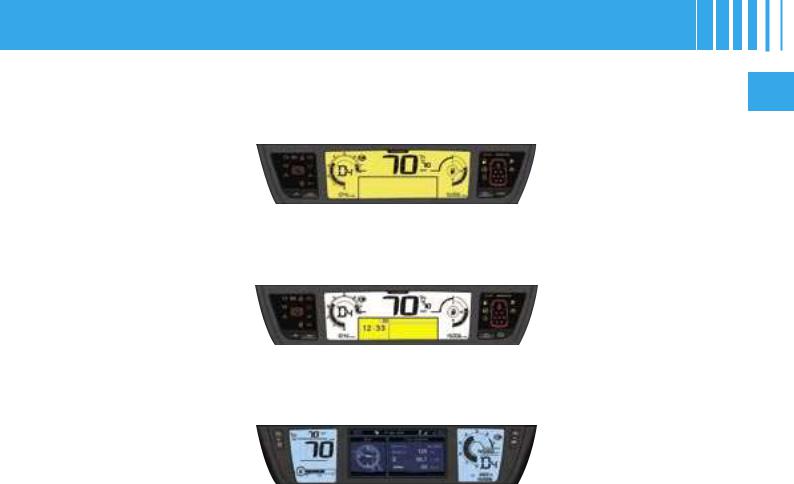
INSTRUMENT PANELS
The instrument panel groups all the driving and comfort information at the centre of the dashboard.
Mono-tone instrument panel with multifunction screen A
II
Bi-tone instrument panel with multifunction screen C
NaviDrive instrument panel with multifunction screen DT
31
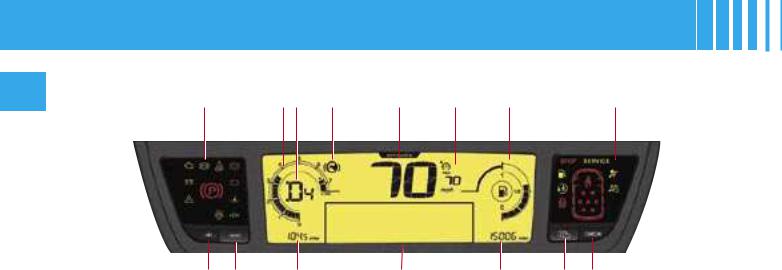
MONO-TONE INSTRUMENT PANEL - MULTIFUNCTION SCREEN A
II
Warning lamps |
1 |
2 |
3 |
4 |
5 |
6 |
Warning lamps |
display |
display |
A B |
7 |
8 |
9 |
C D |
CENTRAL DISPLAY
1.Rev counter
2.Gearbox information
3.« Foot on brake » warning lamp
4.Speed indicator
5.Cruise control or speed limiter reference
6.Fuel gauge
7.Trip mileage recorder
8.Multifunction screen A
9.Maintenance indicator, on switching on ignition, then total mileage recorder
32
COMMAND BUTTONS
A.Lighting rheostat (available day and night)
B.Trip mileage recorder reset
C.Lighting rheostat (available day and night)
D.Check (list of alerts)
:42-45
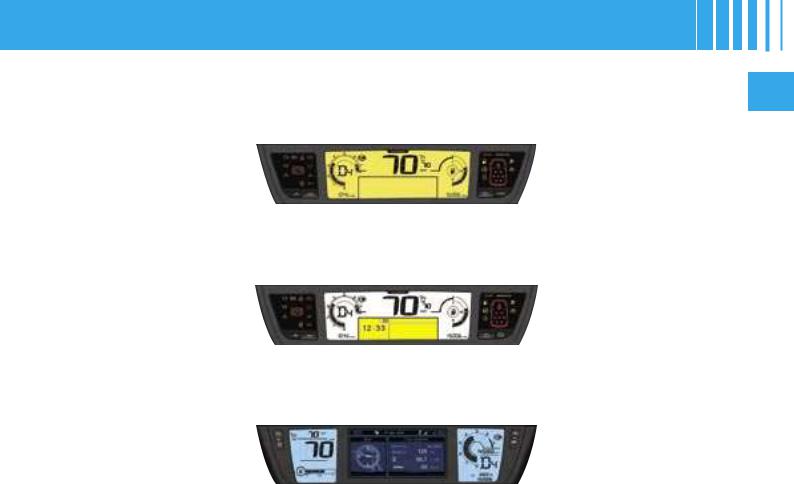
INSTRUMENT PANELS
The instrument panel groups all the driving and comfort information at the centre of the dashboard.
Mono-tone instrument panel with multifunction screen A
II
Bi-tone instrument panel with multifunction screen C
NaviDrive instrument panel with multifunction screen DT
31
